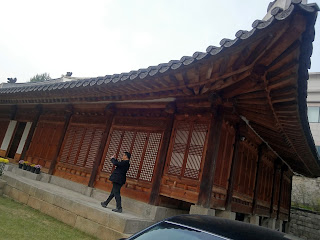Pilgrimage to the shrine of martyrs
The second part of our day was highlighted by a pilgrimage to the place of martyrdom, the Jeoldusan Martyrs’ Shrine. There were several waves of persecutions of Catholics since the first in 1791. This was the site of the beheading of Catholics who were suspected of helping the French invade the Joseon coast in 1866.
This event sparked the fifth major persecution of Catholics and led to the execution of many. Why was this site chosen? It was on a high hill overlooking the transportation, trade, and business on the Han river between China, Japan and Western powers. Since the Catholics were considered to be the culprits enabling the French invasion, only their blood could wash away the filth of the invasion. This is why after beheading their heads were washed in the river.
Today this is the resting place for the relics of 27 of the martyrs who lost their lives defending their faith. The most famous one was Andrew Kim Tae-gon, the first Korean priest who received the palm of martyrdom on September 16, 1846. A very large bronze statute of St. Andrew Kim wearing traditional garb was erected on the site.
The Catholic delegation celebrated the Eucharist in the chapel after praying in the crypt that contains the relics of some of the martyrs. May the blood of these witnesses of faith inspire all the delegates at the WCC Assembly to seek the unity of all those who believe in Christ and witness to him with lively faith and especially for the unity of this divided Korea.
Gyeongbokgung Royal Palace
Next we went to explore some more of Korean history and culture by visiting the Gyeongbokgung Palace (which translates: Palace Greatly Blessed by Heaven). This Palace was built in 1695 three years after the founding of the Joseon dynasty. It was a beautiful autumn late afternoon with the sun beginning to set when we arrived at the site of the palace.
At the apex of the Joseon dynasty this complex had over 500 buildings. Most of these were destroyed during the Japanese invasion in 1592 since it was the symbolic location of the royal power, politics, economy and culture of the dynasty. After the Japanese occupation, the palace was partially rebuilt and has been restored since 1990 to his past splendor. It is an extremely beautiful complex especially with the fall colors and the play of the light of the setting sun on the buildings and reflection in the water.
We were fortunate to have a guided tour the complex which now consists of only 125 of the original buildings.
The last rays of the setting sun accompanied us to our last stop of our second day.
Representatives of the National Council of Churches
Rev. Kim Young-ju, General Secretary, met us and hosted another traditional Korean meal with its many dishes and surprises. It was 130 years since Protestantism arrived in Korea. The Korean National Christian Council was founded in 1924 which were the beginnings of the Council of Churches in Korea.
We learned that Protestantism established itself first by missionary work in the founding of women’s hospitals and schools for the education of girls. Then came Bible schools. While the Catholic mission was orientated toward the establishment of the hierarchy and a sacramental structure, the Protestant Methodist and then Presbyterians began with the education of women and the establishment of schools. Of course, this is not to say that Catholics didn’t do so as well but it was important to establish the faith in a new cultural setting.
The various mission societies decided that instead of competing for believers they divided the peninsula into mission territories, each being assigned a geographical area. This is how Protestants arrived mainly form the united Stated and Great Britain to evangelize the country.
As I said earlier we had some new dishes to try before calling it a night.
 |
| Buon appetito! |
It was a long day. Tomorrow, our last in Seoul we will visit the Anglican and Orthodox churches and then make our way to Busan and the beginning of the Assembly.
Peace and all good!


















